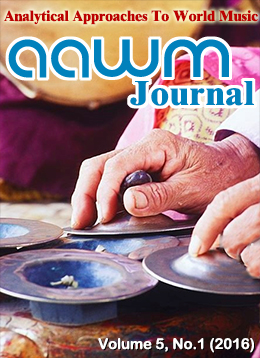 |
| |
 |
 |
|
 |
 |
|
AAWM JOURNAL Volume 5, No. 1 (2016) |
 |
 |
| Volume 5, No. 1 (2016) |
| |
 |
 |
Keynote Address from the Fourth International Conference on Analytical Approaches to World Music
Coordinating Analyses of Tuning with Analyses of Pieces |
| Jay Rahn (York University) |
| Analyses of tunings have often been carried out independently of pieces in which they are actually realized. Whereas tunings are prima facie relevant to pieces in which they occur, to what extent is this so? And does such a relationship hold in both directions? That is, are analyses of pieces relevant to analyses of their tunings?
Both sorts of analysis involve methodological problems and, at least in principle, both sorts of analysis should mesh. Germane to the present discussion are instances of such analytical problems that arise in Central Javanese pélog tunings and in ‘skeletal melodies’ (balungans) of multi-section pieces (gendhings) that employ these tunings.
The present account identifies such problems and proposes solutions that attempt to coordinate both sorts of analysis. With regard to tuning per se, relationships among acoustical spectra, pitch determinacy, interval categorization, and ‘errant tones’ are considered. Concerning individual pieces, both jointly and severally, longstanding notions about ‘exchange,’ ‘alternate,’ or ‘substitute’ tones (sorogan), modal identity (pathet), and cadential (gong) tones are addressed.
Linking both kinds of analysis—and shared by both—is an amplified formulation of Wertheimer’s Gestalt Grouping Principle of Similarity. Introduced from post-tonal analysis of European-derived music are concepts of common tones, ‘well-formed’ (WF) scales, and interval vectors... more >> |
| |
 |
 |
| The Byar: an Ethnographic and Empirical Study of a Balinese Musical Moment |
| Andy McGraw (University of Richmond) with Christine Kohnen (Carleton College) |
| The Balinese gong kebyar repertoire is marked by virtuosic, unmetered tutti passages, referred to as kebyar, which often begin with a byar, a sudden, tutti chord performed by the majority of the ensemble of 20-30 musicians. This paper investigates the claim, made by some Balinese musicians, that they could audibly identify various village ensembles by hearing their byar alone. This claim related to purely temporal relations (the orchestra’s onset profile) rather than the tuning or timbral quality of the instruments. Such a task would be equivalent to being able to identify symphony orchestras by hearing, for example, only the first sforzando of Beethoven’s Eroica symphony. This paper combines ethnographic, statistical and cognitive techniques to determine whether or not this is possible. The paper’s first section is an analysis of the empirical differences between byars performed by six ensembles. The results of the empirical measurement demonstrate that, while each village demonstrated considerable variation in their byars, they tend to have unique and somewhat consistent approaches that allow us to predict which village a byar might originate from. We describe these tendencies in terms of overall latency of byars and trends in their onset profiles. The second section of the paper discusses the results of a survey and listening experiment in which respondents attempted to match recordings of byars with their respective ensembles. A series of confounding factors that may have influenced the recordings and the results, many of which were suggested by Balinese informants, is discussed for their potential impact upon the empirical measurements. Next, we present an ethnographic discussion of Balinese’ explanations for perceived differences between regional interpretations of the byar. For a listening experiment designed to measure accuracy in identifying byars, respondents were selected from three populations: Balinese musicians, non-Balinese students of gamelan and non-Balinese with no experience of gamelan. Prior to identification, Balinese informants correctly identified randomized examples only 21% of the time. After identification their accuracy increased to 40%. In both cases informants were able to correctly identify a subset of the samples well above chance. Their accuracy rate was much higher than the population of non-Balinese with gamelan training (25% of the time) and a non-Balinese population with no gamelan experience (23%) of the time. The results demonstrate the extent to which perception of this single musical moment is based upon learning and immersion in a style... more >> |
|
|
 |
|
 |
 |
|



